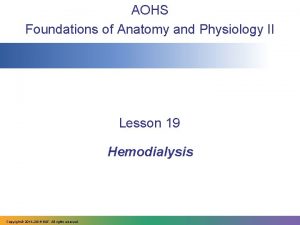AOHS Foundations of Anatomy and Physiology II Lesson

















- Slides: 17

AOHS Foundations of Anatomy and Physiology II Lesson 16 Innate Immune Defenses Copyright © 2014‒ 2016 NAF. All rights reserved.

By the end of this presentation, you will know: • The cells involved in the innate immune system • Chemicals involved in the innate immune system • How the inflammation response happens • How fever happens

Sneezes shoot bacteria, viruses, and body chemicals at up to 100 mph Your innate body defenses react the same whether the sneeze exposes you to bacteria, viruses, or some other potential invader. What different “infectious” threats can you think of that you encounter every day?

Physical barriers are your first line of innate defense Hair, skin, cilia, and mucus keep potentially harmful invaders out in several ways. Many organs have cells or substances that serve as protective barriers. Cilia on bronchial cells

Your second line of innate defense involves types of white blood cells and other special cells White blood cells, often called leukocytes, are made in your bone marrow. Not all leukocytes mature in the same way. Some migrate to the thymus as part of their maturation process. White blood cells What type of bone marrow produces blood cells?

Leukocytes can tell what should be in your body and what shouldn’t Leukocytes identify what should be in your body by recognizing antigens. Your immune cells give an okay to antigens you were born with but not to ones that are new. What happens when a person receives blood that contains an antigen his or her body doesn’t recognize?

Leukocytes are all around your body, and they have an ability to move Leukocytes, like this macrophage, can travel to any part of your body. They have a few tricks: some can change shape and size, and others can replicate themselves quickly. A macrophage engulfing an old red blood cell

There are three types of phagocytes Name of cell Characteristics Neutrophil Most plentiful white blood cell, very mobile, quick to attack invaders. Roams through the circulatory system, ready to enter tissues where and when it’s needed. Lives for a few hours to a few days. Eosinophil Engulfs pathogens or compounds that have been identified by other cells. Lives about 8‒ 12 days. Macrophage Long-lived, large cells. Some stay in specific tissues, whereas others can migrate to a site where they’re needed. Lives months to years.

Natural killer (NK) cells attack cancer cells and cells infected by viruses NK cells kill their target cells by secreting chemicals that cause the target cell’s membrane to disintegrate. NK cell cancer cell

Proteins in blood plasma, called complement, bind to the membranes of foreign cells When complement binds to foreign cell membranes, the complement proteins become activated. They make tiny holes in the foreign cell membrane, killing the cell. What do you imagine would cross the cell membrane if there are holes in it?

Interferons are proteins that “interfere” with the activity of viruses Cells infected with a virus can secrete interferons, which tells neighboring cells to take defensive steps against a viral attack. Molecule of interferon

When you’re injured, damaged cells release chemicals called histamines and kinins The inflammatory chemicals histamines and kinins are the security system’s warning that there’s been a break-in. They start off a set of responses that result in inflammation. What do you guess antihistamines do?

Histamines and kinins cause blood vessels near the injury to dilate Histamines and kinins also make capillary walls leaky so that plasma and neutrophils can easily leave the blood and go to the space between cells. These responses account for the redness, heat, and swelling of inflammation.

Inflammation is the body at work protecting and repairing the site of an injury Inflammation is characterized by four signs: • • Redness Heat Swelling Pain What incidents have caused inflammation for you?

Clotting proteins in the blood form a mesh that isolates the injury Chemicals released from the clot will also stimulate healing of the damaged tissue.

A fever is your whole body responding to infection When white blood cells meet certain pathogens, they secrete chemicals called pyrogens. Pyrogens reset your body’s thermostat so that you heat up. If you have a fever of 104, do you treat it differently from a fever of 100? Why?

You come into the world with some sophisticated systems to help you stay healthy From the day you’re born, your innate body defenses work together to guard you from invaders, whatever shape they take.
 Aohs foundations of anatomy and physiology 1
Aohs foundations of anatomy and physiology 1 Aohs foundations of anatomy and physiology 2
Aohs foundations of anatomy and physiology 2 Aohs foundations of anatomy and physiology 1
Aohs foundations of anatomy and physiology 1 Aohs foundations of anatomy and physiology 1
Aohs foundations of anatomy and physiology 1 Aohs foundations of anatomy and physiology 1
Aohs foundations of anatomy and physiology 1 Aohs foundations of anatomy and physiology 1
Aohs foundations of anatomy and physiology 1 Aohs health careers exploration
Aohs health careers exploration Upper respiratory labeled
Upper respiratory labeled Tattoo anatomy and physiology
Tattoo anatomy and physiology Anatomy science olympiad
Anatomy science olympiad Crown plants examples
Crown plants examples Anatomy and physiology of bone
Anatomy and physiology of bone Stomach ulcer
Stomach ulcer Liver physiology and anatomy
Liver physiology and anatomy Hypogastric region
Hypogastric region Epigastric region
Epigastric region Straw coloured fluid
Straw coloured fluid The central sulcus divides which two lobes? (figure 14-13)
The central sulcus divides which two lobes? (figure 14-13)






























